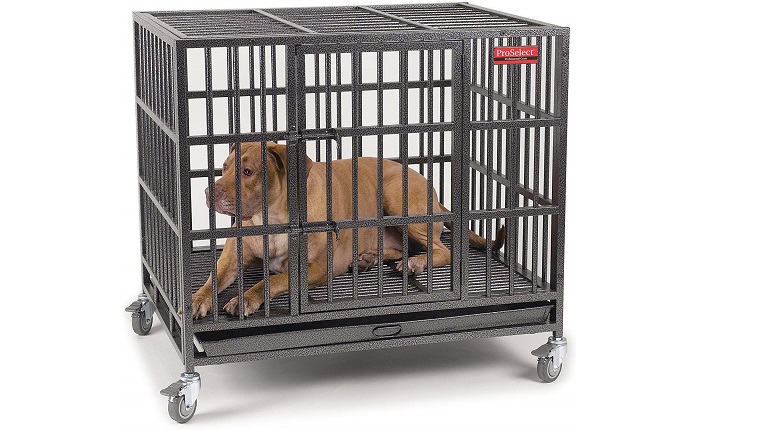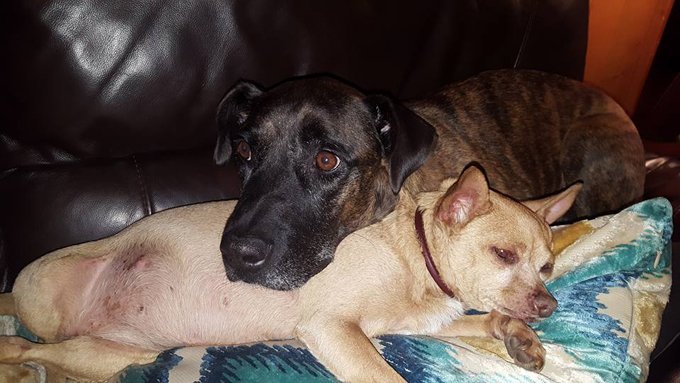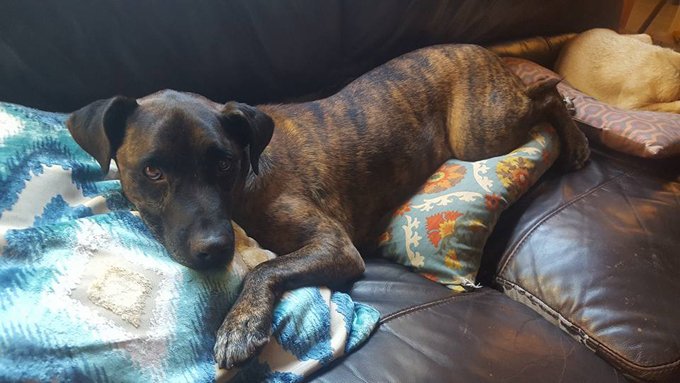Many of us pet parents have one or more dogs who suffer from separation anxiety to varying degrees.
I have a rescue dog, named Joe, who spent seven years of his life alone in a dirt dog run. Rain, snow, sun — he was alone, and he had no shelter. He was cold, and hungry, and lonely, and afraid. That’s the life he knew before coming to live with us.
Now, he lives indoors with our other three dogs. He sleeps on a huge faux leather sofa all day. He’s warm, he’s cozy, and he’s got plenty of food and water.
But Joe Is Afraid
Joe is afraid of loud noises, new people, new objects, and many other everyday things a normal dog in your average house has to deal with. But he especially freaks out when we leave home, even though all of his needs are met and there are three other dogs in the house.
When we leave, Joe acts out to the point that he tore our dog crate apart, broke a window screen, jumped a five-foot cinder block wall, and ran out into the busy streets of Los Angeles looking for me while I was away for an hour having lunch with a friend.
Joe is a large dog, and at ten years old, he’s no spring chicken. So jumping a five-foot wall was not even something I thought he could do at this age. It was horrifying for me, so I can only imagine the terror that drove him to accomplish such a feat.
Luckily a woman was able to capture him — God knows how she did it — and he was back home within the hour.
It’s heartbreaking to think that the simple act of us leaving the house for a short time causes him such distress. However, it’s unrealistic for us to spend the rest of our lives at home.
We had to come up with solutions for Joe’s anxiety problem.
How We’re Helping With Joe’s Separation Anxiety

First of all, it was obvious that we had to invest in a much sturdier dog crate. The regular kind wasn’t secure enough for him. He was able to bend the door back, and somehow he knocked it open while bending it, rendering the crate unusable.
A friend who does rescue work suggest we get the ProSelect Empire Dog Cage. It is not cheap. But we decided to make the investment, even though it’s pricey, because knowing that Joe is safe when we go out means everything to us. I wouldn’t even be able to relax if I didn’t know my dogs were all safe at home.

This crate is no joke. On top of being expensive, it’s huge and unattractive. It looks like we’re housing circus animals, but we’re hoping that in a year our new dog won’t need to be in the cage every time we go out.
The cage is very solid and sturdy. It doesn’t feel like a crate; it doesn’t rattle or move around. The bars are smooth and far apart so he cant’ get his nails suck in the small bars. There are wheels to help you move the cage from room to room with ease, but you can also lock the wheels into place, and they won’t move.
Helping Joe Get Used To The Crate

We placed a large dog bed in the crate, laid a blanket over the cage to make it dark and secluded, and spent a week putting him into the cage for a few minutes at a time, handing him treats, then opening the door and letting him out with lots of love and praise.
Now he loves his new crate and sleeps in it at night with the door open all on his own. This is such a relief to us. We just want him to be happy. And no I am not being paid to talk about this crate. When you need it, you need it, and that’s all there is to it.
Leaving Joe At Home
Coaxing Joe into the cage when he knows we’re about to go out isn’t easy. Once he sees shoes going on or me grabbing my purse, the jig is up.
So now I put Joe in the cage about ten minutes to a half hour prior to leaving — before I’ve given him any hint or indication that I’m planning on going out of the house.
That way I can go back and visit him in the cage, which is in our bedroom, a few times and hand him treats and reassure him before we actually walk out the door.
When it’s time to go into the cage I call all of the dogs over for treats in the kitchen or living room area and then get a hold of Joe’s collar. Sometimes I pull out a dog leash when he comes to me, and I clip it on and walk him back to the crate. He seems to willing go anywhere when there’s a leash on him.
I never shove or force him into the cage. I always do it in a calm and relaxed way. If he pulls away from me, I stop and I pet him and reassure him, and when he relaxes, we continue to the cage. When he gets into the cage he gets treats.
The bars on the cage are wide and I can stick my hands in and pet him and give him love while he’s in the cage, which I do often.
I turn the TV on a low volume before I leave so he has the sounds of people talking — but not a blasting TV — and I leave the lights on in the room the cage is in. I try to make the atmosphere as cheerful and comforting as possible.
Joe Is Settling In And Taking Baby Steps

Joe has lived with us for about four months now, and I’m finally starting to leave him out of the crate for short, five-minute time periods. I go outside and I back the car out of the driveway, go around the block, and come back home.
I set up a camera in the hallway one time, and I can see that when we leave, he paces around looking for us. But I keep his time alone short — no more than five minutes — and I get home and hand out treats and affection before he can get into any trouble. Baby steps.
I’m going to continue to increase my time away to ten minutes, and I’m hoping that, by the end of the year, we will be able to go out to dinner, and Joe will be able to roam freely in the house with the other dogs.
But it’s a work in progress. We’ll see how it goes. One day at a time when you have a dog with severe separation anxiety.
Do you have any tips for helping a dog with extreme separation anxiety? How do you keep your dog comfortable while you’re away from home? Let us know in the comments below!
Click the bold links in the article to shop for your dog and support our content!









